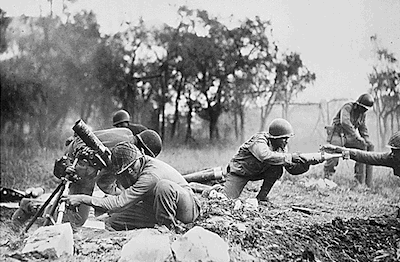The 92nd Infantry Division, a military unit of approximately fifteen thousand officers and men, was one of only two all-black divisions to fight in the United States Army in World War I and World War II. The 92nd Division was organized in October 1917 at Camp Funston, Kansas, and included black soldiers from across the United States. Before leaving for France in 1918, it received the name “Buffalo Soldier Division” as a tribute to the four Buffalo soldier regiments that fought in the regular U.S. Army in the nineteenth and early twentieth centuries.
After their arrival in France, the soldiers were deployed to the front lines in August 1918. The division saw action primarily in one of the last Allied operations of the war—the Meuse-Argonne Offensive that begin in September and ended with the Armistice on November 11, 1918. The 92nd Division, unlike the 93rd, the other all-black division in World War I, fought under American command. When World War I ended, the division returned to the United States and was deactivated in February 1919.
After the United States entered World War II, the 92nd Infantry was reactivated on October 15, 1942, and trained at Fort Huachuca, Arizona, with the 93rd Infantry, the other all-black division. After that training was completed, the 92nd was deployed to Italy while its counterpart was sent to the South Pacific. On July 30, 1944, the first units of the 92nd arrived in Naples, Italy, and by September 22, the entire division was stationed in the Po Valley in North Italy. Assigned to the U.S. Fifth Army, the 92nd Division also included the 442nd Regimental Combat Team, the all-Japanese American (Nisei) unit that both suffered some of the heaviest casualties of the war and became one of the most decorated U.S. military units.
The division first saw significant action against German troops and Italian troops in September, and by October, they were engaged in offensive campaigns in the Serchio River Valley and along the coast near the city of Massa. On April 29, 1945, elements of the 92nd Division liberated the Italian cities of La Spezia and Genoa. They participated in other battles in Northern Italy, often in fighting that involved both advances and retreats until May 2, 1945, when all German forces in Italy surrendered. During this fighting, First Lt. John R. Fox won the Medal of Honor for his action in the Serchio Valley on December 26, 1944, and First Lt. Vernon J. Baker won the medal for his action near Viareggio on April 5–6, 1945. Both medals were not awarded until 1997. The 92nd Division returned to the United States on November 26, 1945, and was deactivated two days later on November 28, 1945.

